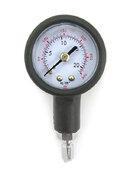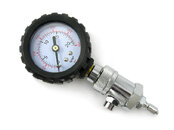Blue Sparkle
Contributor
I would like to buy an IP gauge so that I can check my own regs. Right now I don't plan to service them myself, but I would not rule that out in the future.
My question comes in because I see two different types for sale (and this seems to be common at more than one source).
One is like this one, which runs about $16 and seems to be the basic one:

The compact 1.5-inch diameter, ultra-lightweight, dual scale (PSI and BAR), intermediate-pressure gauge is ready to go with you anywhere. Perfect for helping diagnose problems in the field, it plugs into any standard BC low-pressure inflator hose.
**********************************************
And the other the "deluxe," which is about $50:

Quickly check and adjust regulator intermediate pressures by plugging in to the low-pressure QD BC hose. The Deluxe IP Check Gauge makes precise IP adjustment faster with easy to use bleed (twist in either direction) that gives a quick vent and an over-pressure relief valve set at 200 psi. The large 2-inch diameter gauge has a protective rubber boot and dual scales (PSI and BAR) with accuracy of 1.5% throughout the entire range.
I don't know what a "bleed" is. Is the difference that you can only check the IP with the first one, but can check AND adjust it with the second one?
I don't mind spending money on quality tools (if I have a use for them), but I would like to understand what I might gain or lose by choosing one of these IP gauges over the other.
It probably does not matter, but my reg set is a Zeagle Flathead VI first stage, with ZX and Envoy second stages.
Thank you!
Blue Sparkle
My question comes in because I see two different types for sale (and this seems to be common at more than one source).
One is like this one, which runs about $16 and seems to be the basic one:

The compact 1.5-inch diameter, ultra-lightweight, dual scale (PSI and BAR), intermediate-pressure gauge is ready to go with you anywhere. Perfect for helping diagnose problems in the field, it plugs into any standard BC low-pressure inflator hose.
**********************************************
And the other the "deluxe," which is about $50:

Quickly check and adjust regulator intermediate pressures by plugging in to the low-pressure QD BC hose. The Deluxe IP Check Gauge makes precise IP adjustment faster with easy to use bleed (twist in either direction) that gives a quick vent and an over-pressure relief valve set at 200 psi. The large 2-inch diameter gauge has a protective rubber boot and dual scales (PSI and BAR) with accuracy of 1.5% throughout the entire range.
I don't know what a "bleed" is. Is the difference that you can only check the IP with the first one, but can check AND adjust it with the second one?
I don't mind spending money on quality tools (if I have a use for them), but I would like to understand what I might gain or lose by choosing one of these IP gauges over the other.
It probably does not matter, but my reg set is a Zeagle Flathead VI first stage, with ZX and Envoy second stages.
Thank you!
Blue Sparkle




